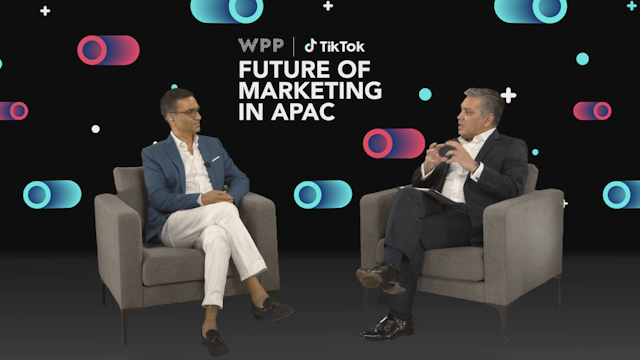TikTok and WPP on mastering creative, commerce and consumer influence
WPP and TikTok have set the blueprint for the future of marketing in APAC, hosting an event where marketing leaders and creators discussed how to master creative, commerce, and consumer influence on the world’s fastest growing video platform.
2021 has been nothing short of game changing for TikTok, as it hit over 1 billion users globally and became the fastest growing app in the world. It is also the year that brands really started to unlock the power of the platform and created content that truly resonated with its audience.
The Drum has selected some key insights to tease from the event, but you can view the full session on demand here.
Creativity is different on TikTok
Three of WPP’s top creative minds gathered on a panel about creativity on TikTok, representing a diverse perspective here in APAC.
With so much incredible creator content on the platform, brands need to stand out and Thasorn ‘Pete’ Boonyanate, executive creative director, Thailand, Wunderman Thompson, says the way to do this is to understand that TikTok is more than a platform.

“TikTok is not a platform, it is a culture of Gen-Z and millennials,” he says, “There are many platforms but before the format of the content was pretty long but once TikTok arrived, all video moved towards shorter, more impactful formats. It’s influential at a culture-level to me because it’s changing the way people watch content.”
For Valerie Madon, chief creative officer Asia, VMLY&R, the common mistake for creatives to avoid on TikTok is “swimming in the sea of sameness”.
“Don’t copy. Don’t just do another challenge. Disrupt with a fresh approach that still fits the nature of the content that people will enjoy,” she says.
“Do it with another creative spin, though bring something surprising because it’s only then that you're going to get exponential sharing. Yes, challenges work, but how do you do it differently and in a fresh way that no one has seen before? Inspire other people to actually want to copy you,” she adds.
Another trap that creatives can fall into when working on new platforms is to think short term. Andreanne Leclerc, head of social and performance, Asia, Ogilvy, explains, “Try different approaches, tactics, features and see what works. They all have their special power. A TikTok challenge a year is not enough.”
“You need to think early about an always-on strategy. What are the images that the brand can put up there on an ongoing basis so people can create around it? What type of relationship do I want to develop with creators?” she adds.
Social commerce hits its stride
There has been a shift, driven by consumers, to platforms primarily dedicated to content and social connections, like TikTok, becoming incredibly effective at driving e-commerce sales. The promise of social commerce may have felt a long time coming but data is showing that it is now hitting its stride. Global social commerce revenue is forecast to grow over 28% per annum and from $585 billion in 2021 to $3.37 trillion in 2028, according to Statista.
A recent GroupM Consumer Eye study reported of consumers who had seen an influencer product/brand endorsement, 53% were in Health, Beauty & Personal Care and 38% of all consumers who have purchased a product from a livestream, did so in the same categories.
This prompted a fascinating fireside chat between GroupM APAC CEO Ashutosh Srivastava and Vismay Sharma, president of L’oreal South Asia Pacific, Middle East and North Africa.
Both Sharma and Srivastava noted that what was working on the TikTok platform was the ability to use social commerce tools and formats while galvanizing more organic promotion for its products using creators and community-driven content.

“TikTok is proving to be very good at awareness and engagement and we are beginning to see some capabilities in social commerce – for instance, we now see pages on e-retailer sites dedicated to products that ‘TikTok Made Me Buy It!’” explains Srivastava.
What excited both, however, was what was coming down the line as technology, such as AR and VR starts to evolve on platforms like TikTok.
Sharma, shares, “At L’Oréal we are committed to be the number one beauty tech company. Our beauty tech ambition is to exponentially augment L’Oréal’s game-changing science with cutting-edge technologies, at scale, to deliver unsurpassed beauty experiences. In the area of AR, we acquired Modiface in 2018 which is AR/VR company and one of the key services we are heavily investing is Virtual Try On – which allows L’Oréal to provide our consumers best in class shopping experiences/trials online. In fact, video platforms, such as TikTok, have already deployed Virtual Try on filters across our social pages and websites. In 2021 in South Asia, on a specific e-retailer platform, we have had almost 12 million users (5.5 million unique).”
Creators and collaboration move consumer engagement
Of course, one of the biggest draws to TikTok is the huge community of young creators that are building their own audience empires because they have a unique view on what content the TikTok audience wants to see.
One of these is Singapore-based Ng Ming Wei, better known as @mingweirocks on TikTok, who has amassed over 20 million followers through his clever take on prank-style videos, often featuring his dad.
Working with creators authentically isn’t always second nature to brands, however, and he used his time at the event to share advice for brands that want to work with creators on TikTok. ”Creators help advertisers improve their reach and creativity,” he said, adding, “Having creative freedom is important for successful brand collaborations.”
Samuel Vanel, head of INCA, Southeast Asia, a WPP agency that has been heavily involved in the creator aspect of the two companies partnership, adds that content creators are key to most brands content strategy but authenticity is key.
“They are empowering brands to produce content at scale with a more authentic voice. As content marketing is growing, collaboration with content creators will evolve for more authentic engagement, better content distribution, and more creative freedom,” he explains.
One of the fundamental principles of TikTok’s platform is around the joy the content brings, so Justin Keh, head of operations, TikTok Creator Marketing Solutions, APAC, TikTok, says this is something brands need to consider when working with creators.
He also shares how TikTok is launching tools to help brands and creators work better with one another.
"TikTok is committed to making brand and creator collaborations easy by building solutions such as the TikTok Creator Marketplace that lets brands embrace creativity on our platform, connects them to our diverse and upcoming ecosystem of creators, and enables more engagement with their community,” he says.
The theme of joyful content rang true throughout the event, with Sam Singh, TikTok's head of global business solutions, APAC, summarising the emotional pull of content on the platform.
“TikTok users come for the creativity, stay for the content and leave feeling happy and inspired. People love the positive experience that our platform provides, so they scroll longer and dive deeper. In fact, 7 in 10 people who visit TikTok, come when they want to feel joy.”
To hear the session in full, watch the session in catch up now. The session begins at 4min 37sec.
This article was produced in partnership with WPP and TikTok for the Future of Marketing in APAC event.
